Outbreak of violence
The violence began when construction crews on Waddington's Road entered the territory of the Tsilhqot'in nation without permission, after members of the First Nation had been working on road construction and going without compensation, being lied to time and time again, near starvation. [8] Construction had been underway for two years when, on April 29, 1864, a ferryman named Timothy Smith, stationed 30 miles up the river, was killed after refusing a demand from Chief Klattasine (Lhatŝ'aŝʔin: ″Nobody Knows Him″, ″We Do Not Know His Name″), Tellot and other Tsilhqot'in for food. Smith was shot and his body thrown into the river. His food stores and supplies were looted. A half ton of provisions were taken. A skiff was chopped to pieces and the ferry scow set adrift, leaving only the cable over the river. [10] The following day the Tsilhqot'in attacked the workers' camp at daylight. Three men, Peter A. Petersen, Edward Moseley and Philip Buckley, [11] though injured (Moseley was unharmed), escaped and fled down the river. The remaining crew were killed and their bodies thrown into the river.
Four miles further up the trail, the band came upon the foreman, William Brewster, and three of his men blazing trail. All were killed. The band also killed William Manning, a settler at Puntzi Lake.
A pack train led by Alexander McDonald, though warned, continued into the area and three of the drivers were killed in the ensuing ambush. In all, nineteen men were killed.
In New Westminster, Governor Seymour, just a month into his term, received news of the attacks on May 14. The next day Chartres Brew and 28 men were sent to Bute Inlet aboard HMS Forward , but they were unable to make their way up the trail from the Homathko valley to the scene of the incident, and returned to New Westminster. A second party of 50 men under Gold Commissioner William Cox went to the area using an overland route, met an ambush and retreated. Brew, aboard HMS Sutlej, along with the Governor and 38 men, went out again to reach the Tsilhqot'in from Bentinck Arm. They arrived July 7 and met Cox. Donald McLean led a scouting party to reconnoitre. A guide, hearing a rifle click, urged him to get down; he did not heed the warning and was shot through the heart.
Arrest and execution of Tsilhqot'in chiefs
In 1864, Chief Alexis and a slave of Klattasine met with Cox and were given assurances of friendship by Cox. Tsilhqot'in chiefs believed that they were going to attend peace talks. [8] The next day Klattasine, Tellot and six others arrived. They were arrested. Although denied by Cox, they claimed to have been offered immunity. The prisoners were returned to Alexandria. Five of the Tsilhqot'in men (Tellot, Klattasine, Tah-pitt, Piele, and Chessus) were arrested and charged with murder. They were tried in September 1864 at Quesnel at a trial by jury overseen by Judge Begbie. In defence of their actions, Klattasine said they were waging war, not committing murder. The five were found guilty and sentenced to hang. The day they were executed is now a day of mourning in the Tsilhqot'in Nation. The sixth chief, Chief ʔAhan was executed a year later, on July 18, in New Westminster. [8]
The incident cost the colony about $80,000. A petition to the Imperial parliament to share this cost was declined. Donald McLean's widow was given a pension of £100 per year for five years. Waddington sought compensation of $50,000 from the colony, saying that his party had been given no protection. The colony declined, saying that none was requested, and no state could guarantee its citizens safety from murder.
Waddington was of the view that fears of the introduction of smallpox was the cause of the unrest. Frederick Whymper, an artist attached to Waddington's crew, attributed the unrest to the provision of firearms to the Chilcotin at a time when they were suffering from lack of food. Judge Begbie concluded that the most important cause of the unrest was concern over title to land rather than "plunder or revenge". Others say that the native packers in Brewster's crew were starving while the white members of the crew were well supplied. There were also grievances about desecration of graves and interference with valuable spring waters.
Review of trial
The arrest, trial, and execution of the six Tsilhqot'in chiefs as criminals was challenged by the Tsilhqot'in nation on the basis that the violence was a war between two sovereign nations. [8] The Tŝilhqot’in were acting to protect their lands, people, and way of life from the onslaught of road builders at the time. in 2018, Prime Minister Trudeau stated that the War Chiefs were regarded as heroes to their people.
In 1993 Judge Anthony Sarich wrote a report commissioned by the government of British Columbia, on an inquiry into the relationship between the Aboriginal community in British Columbia and the justice system. As a result of the recommendations in the report, the Attorney General apologized for the hanging of the Chilcotin chiefs and provided funding for an archaeological investigation to locate their graves. [20] The British Columbia government also installed a commemorative plaque at the site of the hanging of the Tsilhqot'in chiefs. [8]
In 2014, the British Columbia government exonerated the Chilcotin leaders. Premier Christy Clark stated, "We confirm without reservation that these six Tsilhqot'in chiefs are fully exonerated for any crime or wrongdoing." [21] This exoneration was reciprocally made by Prime Minister Justin Trudeau, on behalf of the Government of Canada, on March 26, 2018, in a speech to Parliament. [22] During the exoneration speech, the then current Chiefs of the Tŝilhqot’in Nation were invited onto the floor of the House of Commons and provided a drum song. This was the first time in Canadian history that an Indigenous Nation was invited onto the floor of the House of Commons. Clark also acknowledged that "there is an indication [that smallpox] was spread intentionally." [23]
On November 2, 2018, Trudeau fulfilled a promise made in his apology speech in March and became the first prime minister to visit the land of the Tsilhqot'in people, where he made another apology speech, this time to the Tsilhqot'in community and its leaders. Trudeau rode into the valley on a black horse, symbolizing the ones ridden by the wrongfully executed chiefs and participated in a smudging ceremony during his time there. [8]
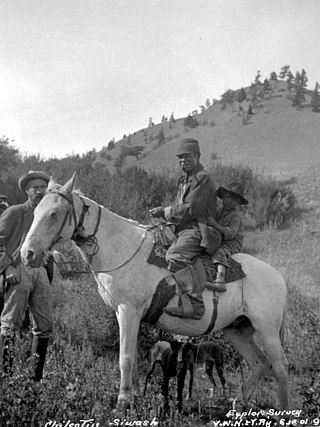
The Tsilhqotʼin or Chilcotin are a North American tribal government of the Athabaskan-speaking ethnolinguistic group that live in what is now known as British Columbia, Canada. They are the most southern of the Athabaskan-speaking Indigenous peoples in British Columbia.
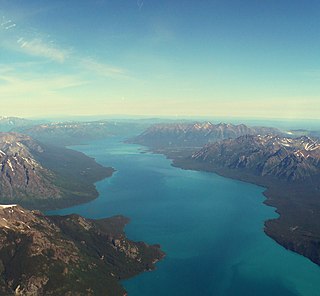
Tŝilhqox Biny, known as Chilko Lake, is a 180 km2 lake in west-central British Columbia, at the head of the Chilko River on the Chilcotin Plateau. The lake is about 65 km long, with a southwest arm 10 km long. It is one of the largest lakes by volume in the province because of its great depth, and the largest above 1,000 m in elevation. It and Harrison Lake are the largest lakes in the southern Coast Mountains.

The Waddington Range is a subrange of the Pacific Ranges of the Coast Mountains in southwestern British Columbia, Canada. It is only about 4,000 km2 in area, relatively small in area within the expanse of the range, but it is the highest area of the Pacific Ranges and of the Coast Mountains, being crowned by its namesake Mount Waddington 4,019 m (13,186 ft). The Waddington Range is also extremely rugged and more a complex of peaks than a single icefield, in contrast to the other huge icefield-massifs of the southern Coast Mountains, which are not so peak-studded and tend to have more contiguous icemasses.
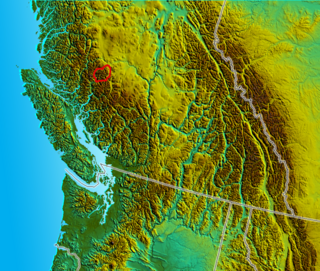
The Niut Range is 3600 km2 in area. It is a subrange of the Pacific Ranges of the Coast Mountains of British Columbia, although in some classifications it is considered part of the Chilcotin Ranges. The Niut is located in the angle of the Homathko River and its main west fork, Mosley Creek. It is isolated, island-like, by those rivers from its neighbour ranges, as both streams have their source on the Chilcotin Plateau in behind the range. Razorback Mountain is its highest peak.

The Homathko River is one of the major rivers of the southern Coast Mountains of the Canadian province of British Columbia. It is one of the few rivers that penetrates the range from the interior Chilcotin Country to the coastal inlets of the Pacific Ocean. The Homathko River reaches the sea at the head of Bute Inlet, just west of the mouth of the Southgate River.

Bute Inlet is one of the principal inlets of the British Columbia Coast. It is 80 km (50 mi) long from the estuaries of the Homathko and Southgate Rivers at the head of the inlet, to the mouth, where it is nearly blocked by Stuart Island, and it averages about 4 km (2.5 mi) in width. Bute Inlet is in a spectacular wilderness setting and is one of the most scenic waterways in the world. In the upper reaches of the inlet mountains rise 2,700 m (9,000 ft) feet above sea level. Bute Inlet is a spectacular wilderness that is visited by very few people. In more recent years tourists are travelling from around the world to view grizzly bears in a natural setting and explore the wilderness of Bute Inlet.

Frederick Seymour was a colonial administrator. After receiving little education and no inheritance from his father, Seymour was offered a junior appointment in the colonial service by Prince Albert. Seymour held positions in various British colonies from 1842 to 1863, when he returned to England.
Lhatŝ’aŝʔin, a chief of the Chilcotin (Tsilhqot'in) people, led a small group of warriors in attacks on road-building crews near Bute Inlet, British Columbia, in April and May 1864. The road crews had been starving and underpaying Tsilhqot'in workers, which provoked Lhatŝ’aŝʔin to declare war. On 29 April 1864, Lhatŝ’aŝʔin arrived at a ferry site 30 mi (48 km) up the Homathko River. He and his warriors killed ferry-keeper Tim Smith, plundering the food and stores kept there.
The Carrier-Chilcotin Tribal Council is a First Nations tribal council located in the Chilcotin District of the Central Interior of the Canadian province of British Columbia, and also on the Fraser River near the city of Quesnel. It consists of three Carrier bands and one Tsilhqot'in band. The other Tsilhqot'in bands belong to the Tsilhqot'in National Government. Most other Carrier bands are either unaffiliated or belong to the Carrier-Sekani Tribal Council. The Tribal Council's offices are in Williams Lake.
ʔEsdilagh is a First Nation community in the North Cariboo region of British Columbia, Canada. It is the smallest of the six member communities that form the Tsilhqot'in National Government. Formerly, the people of this region were known as ʔElhdaqox-t'in, the people of the Sturgeon River. Today, the community goes by the name ʔEsdilagh, which in Tŝilhqot'in language means peninsula.
William George Cox was Gold Commissioner for the Cariboo and Boundary Districts in the Colony of British Columbia, Canada during the Rock Creek Gold Rush. He was born in Ireland.
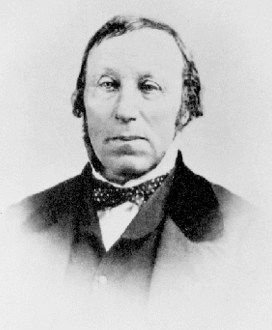
Alfred Penderell Waddington, during his later years, was actively involved in the Colony of Vancouver Island in what later became the province of British Columbia, Canada.

The Tsilhqotʼin National Government (TNG), is the official First Nations government serving the Tsilhqotʼin Nation. Their office is located in Williams Lake, British Columbia, Canada. The member communities represented by TNG are ʔEsdilagh, Tsi Del Del, Yunesitʼin, Tlʼetinqox, Xeni Gwetʼin, and Tlʼesqox. Tlʼesqox also belongs to the Carrier-Chilcotin Tribal Council, as does Ulkatcho - a community with both Dakelh (Carrier) & Tsilhqotʼin heritage. TNG was established in 1989.

The Homathko Icefield is an icefield in British Columbia, Canada. Officially named the Homathko Snowfield from 1950 until the current name was adopted in 1976, it is one of the largest icefields in the southern half of the Coast Mountains, with an area of over 2,000 km2 (770 sq mi). It is located between Chilko Lake and the Homathko River, and lies across the Great Canyon of that river to the east of the Waddington Range. Although adjacent to Mount Queen Bess, the Homathko Icefield is largely an expanse of ice, about 30 km (19 mi) across, ringed by relatively minor peaks and distinguished, relative to the other Coast Mountains icefields, by lack of any major ones. The Lillooet Icecap and the Compton Névé, both similar in size to the Homathko Icefield but much more peak-studded, lie to the Homathko Icefield's southeast across the Southgate River which bends around the icefield-massif's southern flank to reach the head of Bute Inlet adjacent to the mouth of the Homathko River. The icefield is essentially one large ice-girt montane plateau between these two rivers.
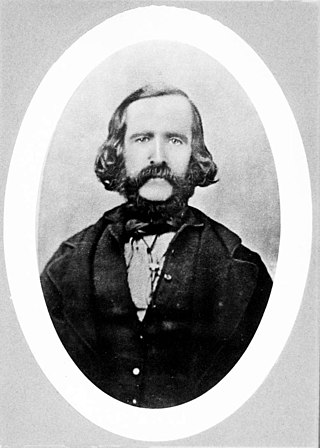
Donald McLean, also known as Samadlin, a First Nations adaptation of Sieur McLean, was a Scottish fur trader and explorer for the Hudson's Bay Company and who later became a cattle rancher near Cache Creek in British Columbia's Thompson Country. McLean was the last casualty of the Chilcotin War of 1864 and the father of outlaw and renegade Allan McLean, leader of the "Wild McLean Boys" gang.

Tatlayoko Lake is a lake on the Homathko River in the western Chilcotin District of the Central Interior of British Columbia, Canada, located on a north-south axis just upstream of the entrance of the series of canyons of the Homathko, including the Great Canyon of the Homathko, on its route to the sea at the head of Bute Inlet. The community of Tatlayoko Lake, British Columbia is located at its northern end.
Canadian Forces Camp Chilcotin is a Canadian Forces training camp in the Chilcotin District, to the west of the city of Williams Lake on the eastern Chilcotin Plateau. The 40977 hectares of land is currently owned by the Federal Government. Within its boundaries, the so-called "Military Block" contains Drummond (Island) Lake, Fish Lake, Callanan Lake, as well as innumerable other small lakes. It also contains the Volcanic Neck, Danilʔaz, and parts of Beecher Prairie.
Puntzi Lake is a lake in the Chilcotin District of the Central Interior of British Columbia. It is located on the western side of the upper Chilcotin River to the northeast of Tatla Lake, and is connected to the Chilcotin River via Puntzi Creek, of which it is an expansion. The area around the lake has been the setting for many important events in the history of the region.
Waddington Harbour is a harbour at the head of Bute Inlet in the Central Coast region of British Columbia, Canada. Also issuing into the head of Bute Inlet and Waddington Harbour, just east of the mouth of the Homathko, is the Teaquahan River. Issuing directly into the inlet a few miles south on the harbour's southeast is the Southgate River, one of the major rivers of the central Pacific Ranges, which begins on the west side of the Lillooet Icecap. Its lower valley adjacent to the inlet's shores is called Pigeon Valley.
The 1862 Pacific Northwest smallpox epidemic was a smallpox outbreak that started in Victoria on Vancouver Island and spread among the indigenous peoples of the Pacific Northwest Coast and into the indigenous peoples of the Northwest Plateau, killing a large portion of natives from the Puget Sound region to Southeast Alaska. Two-thirds of British Columbia natives died—around 20,000 people. The death rate was highest in southeast Alaska and Haida Gwaii—over 70% among the Haida and 60% among the Tlingit. Almost all native nations along the coast, and many in the interior, were devastated, with a death rate of over 50% for the entire coast from Puget Sound to Sitka, Alaska, part of Russian America at the time. In some areas the native population fell by as much as 90%. The disease was controlled among colonists in 1862 but it continued to spread among natives through 1863.












